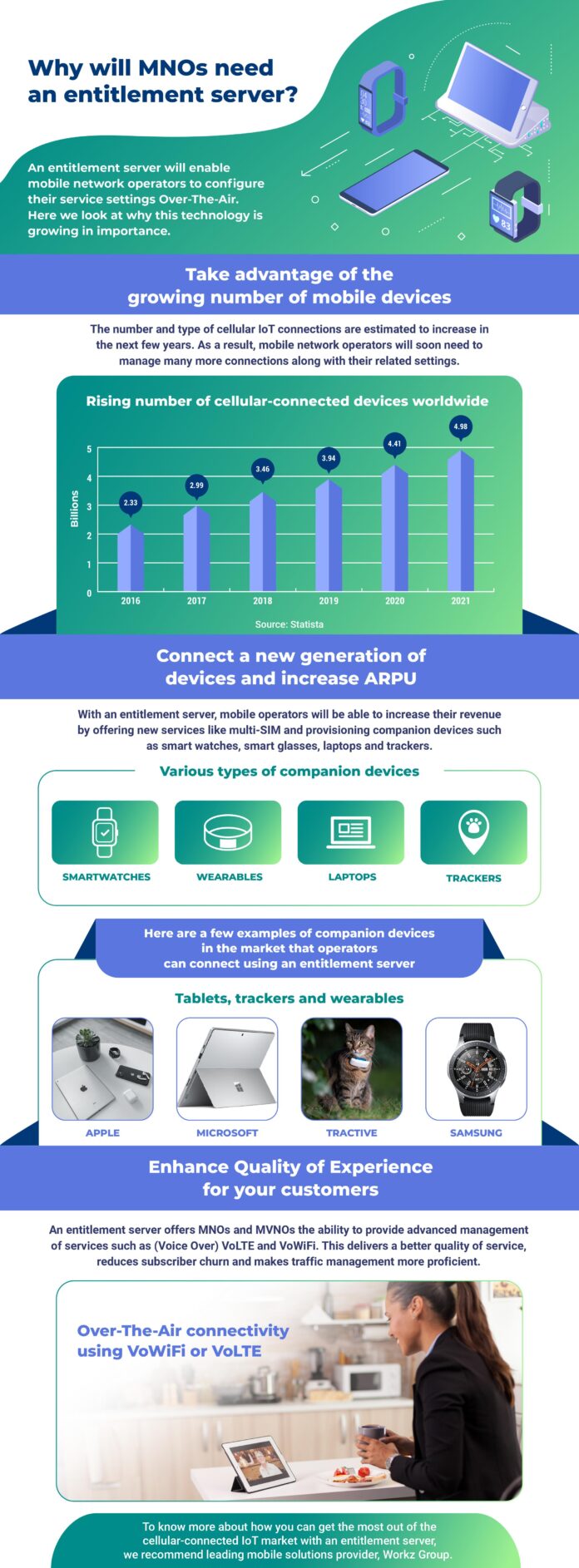We are entering the era of omnipresent connectivity, and consumers are starting to expect continuity of service across all cellular-connected devices.
According to Cisco, there will be 27.1 billion networked devices in 2021 (3.5 networked devices per capita), up from 17.1 billion in 2016 (2.3 per capita). To efficiently manage these devices, MNOs need to implement a truly scalable and flexible device management technology, which is where the device entitlement server comes in.
Future-Proofing Device Management with an Entitlement Server
The job of an entitlement server is to help operators manage subscriber authentication and OTA configuration for service settings across a broad range of cellular-connected devices, including phones, smartwatches, and other wearables. It can also handle the provisioning of companion eSIM devices, such as the Apple Watch or the Samsung Gear smartwatch.
Operators who fail to implement an entitlement server in a timely manner risk losing the ability to meet the growing needs of their customers. The inability to efficiently manage more and more connections and their related settings will likely cause many customers to switch to a different carrier, something eSIM technology makes very easy to do.
Equipped with a scalable entitlement server, operators become able to authorize and provision companion cellular-connected devices for specific device features right upon activation. As a truly future-proof eSIM management solution, an entitlement server allows operators to keep up with device manufacturers, who are constantly pushing innovative features to consumers.
Benefits of an Entitlement Server
For MNOs who are interested in a seamless device management solution that can keep up with the rapidly growing number of cellular-connected devices, an entitlement server is not just a way of gaining a substantial competitive advantage—it’s a necessary investment that ensures the ability to meet the needs of future consumers.
However, all operators who decide to implement an entitlement server can look forward to several important benefits that make the implementation worth the effort. Let’s take a closer look at some of them to better explain where their value comes from.
New Revenue Opportunities
The days when one mobile customer was expected to connect only one mobile device are numbered. An entitlement server makes it easy for operators to facilitate the download of eSIMs for authorized subscribers to all kinds of companion devices.
The smartwatch market alone is projected to reach $96.31 billion by 2027, registering a CAGR of 19.6% from 2020 to 2027. Other emerging markets that represent enormous revenue opportunities for operators with an entitlement server include consumer electronics.
In the near future, it’s likely that all major laptop manufacturers will sell 5G-enabled models with eSIM technology, removing the need for a physical SIM and paving the way for operators to increase revenue by offering new services like multi-SIM.
Better QoS and Reduce Churn
When operators enhance their eSIM management by implementing a device entitlement server, they gain the ability to improve Quality of Service through new value-added services that depend on OTA service configuration, including Voice over LTE (VoLTE), Video over LTE (ViLTE), Voice over Wi-Fi (VoWi-Fi), and Rich Communications Service (RCS).
These IMS-based services provide seamless handoff from cellular to Wi-Fi communication, allowing end-users to make and receive audio/video calls and text messages over a Wi-Fi network instead of a traditional mobile network.
An entitlement server completely eliminates the need for operators to perform a costly integration of each individual device, making it possible for them to handle everything automatically over the air. This results in more satisfied customers who are less likely to seek a relationship with another operator.
Reduced Device Management Costs
An entitlement server is essential for the cost-effective delivery of IMS credentials to end-user devices. The alternative to over-the-air device management and remote configuration of devices supporting value-added services such as VoLTE, ViLTE, VoWi-Fi, and RCS is not only costly but also prohibitively time-consuming.
Operators who automate the entire end-to-end device and subscription orchestration procedure, from the detection of a device, through user authorization and creation of user and subscription profile, all the way to updating the back office system, can expect to see their device management costs dramatically decrease and their average revenue per user (ARPU) increase.
Thanks to cost-effective entitlement servers like Workz Group’s Z-Entitlement, operators can start reaping all the above-described benefits with no setup costs, equipment, or other CAPEX expenses required. With a solution like this, operators can instantly enhance their ability to meet the needs of today’s and tomorrow’s customers alike.








